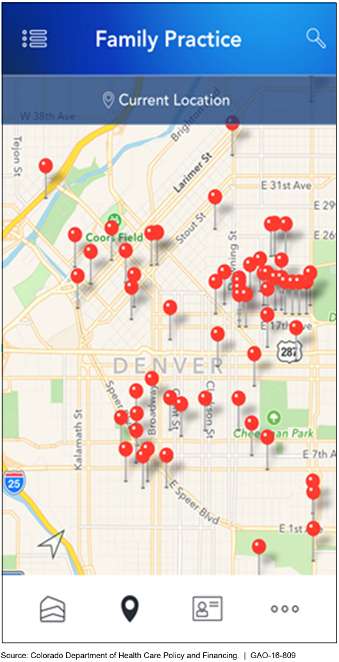Medicaid Fee-For-Service: State Resources Vary for Helping Beneficiaries Find Providers
Fast Facts
How are state governments helping Medicaid beneficiaries connect with participating doctors and hospitals?
Millions of Medicaid beneficiaries are in fee-for-service arrangements, in which states pay health care providers per service—if those providers participate in Medicaid. We looked at the resources available to help beneficiaries find participating health care providers. The 23 states we reviewed had four common types of resources:
searchable provider directories
provider lists
helplines
handbooks
These resources had different amounts of information and states differed in how they adapted resources to meet beneficiary needs.
Colorado's Mobile App to Help Medicaid Beneficiaries Find Providers

Screenshot of mobile app showing health care provider locations around Denver, Colorado
Highlights
What GAO Found
According to the Centers for Medicare & Medicaid Services (CMS), as of July 2014, over 40 percent of nearly 71 million Medicaid beneficiaries were in fee-for-service (FFS) arrangements—traditional FFS and primary care case management—in which participating providers are paid for each delivered service (e.g., an office visit, test, or procedure). The percentage of beneficiaries in FFS arrangements varied widely among states—22 states served between 50 and 100 percent of beneficiaries, almost 16 million people, in FFS arrangements. A recent survey of states suggests that millions remained in FFS arrangements as of July 1, 2015. The survey also suggests that the proportion of beneficiaries in FFS arrangements is declining as states move more populations into risk-based managed care. Aged and disabled beneficiaries and children with special health care needs were the most likely of different Medicaid populations to be served through FFS arrangements instead of managed care.
CMS, the federal agency that oversees Medicaid, and states consider the development of resources to help beneficiaries find a provider to be a state role. CMS supports a federal resource for pediatric dental care and has provided guidance to states related to resources. The 23 states GAO reviewed have 4 common types of resources to help beneficiaries: searchable provider directories; nonsearchable provider lists; beneficiary helplines; and beneficiary handbooks. These resources vary with respect to the scope of information, availability, and states' adaptations to address beneficiary needs. Of the 23 states, GAO found the following:
- 17 had online, searchable provider directories; 16 of these included provider information on specialty care physicians and 4 indicated whether primary or specialty care providers were accepting new patients.
- 23 operated a helpline; 6 operated these outside of regular business hours.
- 9 included a mapping or location feature with their directories or lists.
Helplines are the primary resource that beneficiaries use to report issues finding a provider, according to Medicaid officials in 4 of 6 selected states and half of the advocacy group representatives GAO interviewed. When beneficiaries contact helplines, they can be directed to additional resources—beyond those listed above—to address their complaint.
Why GAO Did This Study
Medicaid is the federal and state health care program for low-income and medically needy individuals including certain children, adults, and aged and disabled individuals. As states transition more Medicaid enrollees and services to managed care, stakeholders have raised questions about populations that remain in FFS arrangements and the resources they can use to find health care providers. GAO was asked to provide information about Medicaid beneficiaries in FFS arrangements.
This report examines (1) the proportion and characteristics of Medicaid beneficiaries served in FFS arrangements, and (2) the federal and state resources available to help Medicaid beneficiaries in FFS arrangements find participating providers and report related challenges. GAO analyzed 2014 CMS data, the most recent available, on the proportion of Medicaid beneficiaries in different service delivery arrangements by state, and a 2015 survey of state Medicaid agencies by the Kaiser Commission on Medicaid and the Uninsured. GAO catalogued online, publicly available information from the 23 states having at least 30 percent of their Medicaid population in FFS arrangements, and confirmed the information via email or interview. GAO interviewed Medicaid officials and advocates in 6 of the 23 states and CMS officials. These states were selected, in part, based on the diversity of delivery system arrangements and resources. GAO also reviewed federal and state resources.
HHS provided technical comments on a draft of this report, which GAO incorporated as appropriate.
For more information, contact Katherine Iritani at (202) 512-7114 or iritanik@gao.gov.
